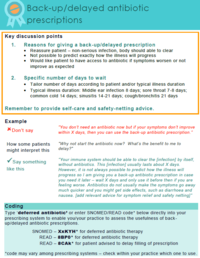Using back-up/delayed prescriptions
How to explain back-up/delayed antibiotic prescriptions to patients
Patients are likely to better understand and accept a back-up/delayed antibiotic prescription if you discuss two key points. These can be incorporated in the last four techniques in CHESTSSS (Timeline, Shortcomings, Self-care, Safety-netting).
It can be helpful to:
- provide reassurance that there is no need for an immediate antibiotic prescription and, if given, the patient is more likely to experience the side effects of antibiotics rather than the benefits;
- although the illness is likely to be self-limiting, acknowledge that it is not possible to predict exactly how the illness will progress;
- and that you would like the patient to have access to antibiotics should their symptoms get worse or not improve as expected.
For example: "wait another 2 days and start the antibiotic if you are not feeling any better by then".
It is important to be specific as your patient may worry about waiting too long if they are not confident about when to start the antibiotics.
Your advice should be tailored to the patient’s current experience of the infection, the prior duration and expected natural history, their co-morbidities, and their ability to access antibiotics in a timely manner.
This table with the average duration of common RTIs [11-14] can be used when tailoring your advice to patients.
| Infection | Average duration of illness |
| Sore throat | 7-8 days |
| Middle ear infection | 8 days |
| Common cold | 14 days |
| Sinusitis | 14-21 days |
| Cough or bronchitis | 21 days |
A copy of this information can be downloaded and printed using the 'Top Tips for Discussing Antibiotics' summary (pdf).
Consider these examples of how you can discuss back-up/delayed antibiotic prescriptions with patients to increase their understanding and satisfaction.
| What some prescribers might say | How some patients might interpret this | Alternative suggestion | |
|---|---|---|---|
| “It’s probably a virus so an antibiotic won't help…here’s a back-up prescription just in case your symptoms get worse.” | "If it’s a virus how will an antibiotic help later?" | “At the moment there are no signs of a serious infection. Your body is fighting the infection and that’s usually enough for you to recover. Most [infection type] usually last X days so the symptoms will most likely go away on their own and you should be feeling better by X day. If you don’t feel better by X day, then you can use the back-up prescription." | |
| “You don’t need an antibiotic now but if your symptoms don’t improve within X days, then you can use the back-up prescription.” | "Why not start the antibiotic now? What’s the benefit to me to delay?" |
"Your immune system should be able to clear this [infection] without antibiotics. Antibiotics do not usually make the symptoms go away much quicker for this type of infection and you might get side effects, such as diarrhoea and nausea, so it would be better to let your body’s own immune system manage this infection. If your symptoms get worse [give specific examples] over the next X days, then you can use the back-up antibiotic." |
Five ways to issue a back-up/delayed antibiotic prescription
The format you use to give a back-up/delayed antibiotic prescription to a patient makes little difference to antibiotic use and patient satisfaction - as long as you give clear advice to patients.
Trial [29] evidence shows that when patients are given a back-up/delayed prescription only around one third start the antibiotics. Find out below the extent to which patients used the antibiotics and their satisfaction with each format.
33% (28/85) of patients used the antibiotic (when asked to collect from practice reception) and 88% (21/24) were very satisfied with the consultation.
In practices with electronic transfer of prescriptions to community pharmacies, prescribers may wish to use this method to help make it easier for the patient to collect the prescription.
37% (37/101) of patients used the antibiotic and 80% (24/30) were very satisfied with the consultation.
37% (34/92) of patients used the antibiotic and 74% (17/23) were very satisfied with the consultation.
This format may be useful in circumstances where you feel it is important for the patient to have the antibiotic at home (e.g., if the patient may find it difficult to access care).
You should advise the patient that if they don’t need to use the antibiotics, they should return them to a pharmacy.
Please bear in mind that there is no current evidence for how this format influences antibiotic use or patient satisfaction.
Coding a back-up/delayed prescription
There is currently no reliable way to report on the use of back-up/delayed antibiotic prescriptions in England. This is because publicly available prescribing datasets are generally based on prescriptions that are dispensed in community pharmacies irrespective of when they were prescribed. Any back-up/delayed prescriptions that were issued and not dispensed would therefore not be captured. Similarly, those that have been post-dated will also not be captured as being post-dated and only captured as an item if dispensed.
If you want to capture the use of back-up/delayed antibiotic prescriptions in your practice, then all prescribers should be encouraged to use the relevant READ/SNOMED codes for 'deferred' antibiotics.
| READ codes (e.g., Emis, Vision) | SNOMED code (System One) |
|---|---|
|
XxKYH - deferred antibiotic therapy |
| Or start typing ‘deferred antibiotic’ and the code should appear | |





